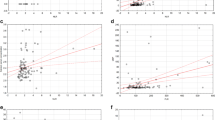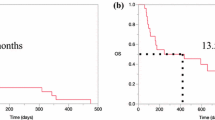Abstract
Recently, reactive thrombosis or platelet to lymphocyte ratio has been reported as a strong predictor of poor prognosis in various types of cancer. However, a study investigating the relationship between platelet counts and thrombopoietic cytokines suggested that low platelet could be important in multiple myeloma (MM), which means platelet count decreased in advanced International Staging System (ISS) stage. Therefore, we developed inverse platelet to lymphocyte ratio (iPLR) and assessed the prognostic value of iPLR in patients with MM. We retrospectively analyzed 283 patients who were treated up front with a novel agent-containing regimen. Patients were classified into three groups based on hazard ratio (HR) according to iPLR: low iPLR (group 1), middle iPLR (group 2), and high iPLR (group 3). Over a median follow-up of 34.8 months, staging by iPLR group had predictive value for progression-free survival (PFS) and overall survival (OS). In addition, staging by iPLR group was a reliable method to predict for survival in patients who presented with renal failure (eGFR < 60 mL/min/1.73 m2) and in elderly patients. Multivariate analyses demonstrated that staging by iPLR group was associated with PFS and OS in patients with MM. In conclusion, this study suggested that iPLR is a simple and reliable inflammatory prognostic factor in the era of novel agents.



Similar content being viewed by others
References
Kyle RA, Rajkumar SV (2008) Multiple myeloma. Blood 111:2962–2972
Palumbo A, Anderson K (2011) Multiple myeloma. N Engl J Med 364:1046–1060
Yang HH, Ma MH, Vescio RA et al (2003) Overcoming drug resistance in multiple myeloma: the emergence of therapeutic approaches to induce apoptosis. J Clin Oncol 21:4239–4247
Offidani M, Corvatta L, Polloni C et al (2008) Serum C-reactive protein at diagnosis and response to therapy is the most powerful factor predicting outcome of multiple myeloma treated with thalidomide/anthracycline-based therapy. Clin Lymphoma Myeloma 8:294–299
Tienhaara A, Pulkki K, Mattila K et al (1994) Serum immunoreactive interleukin-6 and C-reactive protein levels in patients with multiple myeloma at diagnosis. Br J Haematol 86:391–393
Ege H, Gertz MA, Markovic SN et al (2008) Prediction of survival using absolute lymphocyte count for newly diagnosed patients with multiple myeloma: a retrospective study. Br J Haematol 141:792–798
Monreal M, Fernandez-Llamazares J, Pinol M et al (1998) Platelet count and survival in patients with colorectal cancer—a preliminary study. Thromb Haemost 79:916–918
Takahashi Y, Bucana CD, Akagi Y et al (1998) Significance of platelet-derived endothelial cell growth factor in the angiogenesis of human gastric cancer. Clin Cancer Res 4:429–434
Yu D, Liu B, Zhang L et al (2013) Platelet count predicts prognosis in operable non-small cell lung cancer. Exp Therapeutic Med 5:1351–1354
Baranyai Z, Krzystanek M, Josa V et al (2014) The comparison of thrombocytosis and platelet-lymphocyte ratio as potential prognostic markers in colorectal cancer. Thromb Haemost 111:483–490
Allensworth SK, Langstraat CL, Martin JR et al (2013) Evaluating the prognostic significance of preoperative thrombocytosis in epithelial ovarian cancer. Gynecol Oncol 130:499–504
Ozkurt ZN, Yagci M, Sucak GT et al (2010) Thrombopoietic cytokines and platelet count in multiple myeloma. Platelets 21:33–36
Eleftherakis-Papapiakovou E, Kastritis E, Roussou M et al (2011) Renal impairment is not an independent adverse prognostic factor in patients with multiple myeloma treated upfront with novel agent-based regimens. Leukemia Lymphoma 52:2299–2303
Levey AS, Eckardt KU, Tsukamoto Y et al (2005) Definition and classification of chronic kidney disease: a position statement from Kidney Disease: Improving Global Outcomes (KDIGO). Kidney Int 67:2089–2100
Hanahan D, Weinberg RA (2011) Hallmarks of cancer: the next generation. Cell 144:646–674
Demaria S, Pikarsky E, Karin M et al (2010) Cancer and inflammation: promise for biologic therapy. J Immunother 33:335–351
Bugada D, Allegri M, Lavand’homme P et al (2014) Inflammation-based scores: a new method for patient-targeted strategies and improved perioperative outcome in cancer patients. BioMed Res Int 2014:142425
Fritz E, Ludwig H, Scheithauer W et al (1986) Shortened platelet half-life in multiple myeloma. Blood 68:514–520
Greipp PR, San Miguel J, Durie BG et al (2005) International staging system for multiple myeloma. J Clin Oncol 23:3412–3420
Kastritis E, Zervas K, Symeonidis A et al (2009) Improved survival of patients with multiple myeloma after the introduction of novel agents and the applicability of the International Staging System (ISS): an analysis of the Greek Myeloma Study Group (GMSG). Leukemia 23:1152–1157
Kuroda J, Shimura Y, Ohta K et al (2014) Limited value of the international staging system for predicting long-term outcome of transplant-ineligible, newly diagnosed, symptomatic multiple myeloma in the era of novel agents. Int J Hematol 99:441–449
Maltezas D, Dimopoulos MA, Katodritou I et al (2013) Re-evaluation of prognostic markers including staging, serum free light chains or their ratio and serum lactate dehydrogenase in multiple myeloma patients receiving novel agents. Hematol Oncol 31:96–102
Author information
Authors and Affiliations
Corresponding author
Rights and permissions
About this article
Cite this article
Jung, SH., Kim, J.S., Lee, W.S. et al. Prognostic value of the inverse platelet to lymphocyte ratio (iPLR) in patients with multiple myeloma who were treated up front with a novel agent-containing regimen. Ann Hematol 95, 55–61 (2016). https://doi.org/10.1007/s00277-015-2521-x
Received:
Accepted:
Published:
Issue Date:
DOI: https://doi.org/10.1007/s00277-015-2521-x




